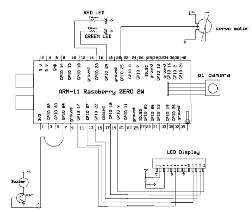Abstract
The Severe Acute Respiratory Syndrome Coronavirus-2 (SARS-CoV-2) causes Covid-19, an infectious illness. A methodology was created to track the vaccination history of people with the Severe Acute Respiratory Syndrome Coronavirus-2 (SARS-CoV-2) that causes Covid-19, an infectious illness. The system operates on a Raspberry Pi processor that is designed to authenticate the vaccination records of individuals. The Vaccination Identification System consists of various components connected to the Raspberry Pi Zero 2W microprocessor, Pi camera, an LCD display, LED indicators, a buzzer, a DC servo motor, and a PCB converter. The proposed system grants access to vaccinated individuals and denies access to those who are not vaccinated..
Keywords:
- COVID-19
- Raspberry Pi Microprocessor
- Vaccination
- DC Servo Motor
Introduction
A brand-new virus that originated in Wuhan, a city in South China, made its way to America and other countries, ultimately devastating central Europe and causing the illness known as COVID-19. Individuals who are infected with the virus have chances to pass COVID-19 to others. When an infected person coughs or exhales, tiny droplets from their mouth or nose can travel through the air and transmit the virus. The government can utilize this initiative to estimate the number of medical necessities, including supplies, medications, and lodging, that will be required in the upcoming days for those impacted by COVID-19 (Hammer et al., 2002). The system will forecast the number of cases and deaths in the upcoming days by examining past data (Roberto et al., 2020). Other vaccine objectives may include reducing mortality and alleviating the burden on healthcare systems by decreasing the number of people requiring hospitalization. COVID-19 vaccinations have already been approved for human use in several countries. To ensure widespread use, they must be dependable, effective, and scalable (Bloomberg, 2020). It is also necessary to address concerns about their effectiveness, side effects, and dosing methods that the scientific community and the general public may have. Formerly, this condition was referred to as "2019 novel coronavirus" or "2019-nCoV". The COVID-19 vaccine trials excluded pregnant women; therefore, the vaccine's effectiveness in this group is unknown (WHO, n.d.).
1. Literature Survey
Roberto et al. (2020) gives a clear idea how to better understand how social stigmas and subsequently prejudice may present additional challenges as nations grapple with restrictions on individuals' movement and move to more normal social interaction. A discussion of COVID-19 in the context of stigmatization, social identity, and social cognition theories offer a means to better understand how those impacted and stereotyped by the virus may also experience negative treatment by others.
McIntosh et al. (2020) depicts a novel coronavirus that was identified as the cause of a cluster of pneumonia cases in Wuhan, a city in the Hubei Province of China. It rapidly spread, resulting in an epidemic throughout China, followed by an increasing number of cases in other countries throughout the world. In February 2020, the World Health Organization designated the disease COVID-19, which stands for coronavirus disease 2019. The virus that causes COVID-19 is due to severe acute respiratory syndrome coronavirus 2 (SARS-CoV-2); previously, it was referred to as 2019-nCoV.
Dhama et al. (2020) mentions that coronavirus disease 2019 (COVID-19) is suspected to originate from an animal host (zoonotic origin) followed by human-to-human transmission, the possibility of other routes should not be ruled out. Compared to diseases caused by previously known human CoVs, COVID-19 shows less severe pathogenesis but higher transmission competence, as is evident from the continuously increasing number of confirmed cases globally.
Liu et al. (2021) explains about the chest Computed Tomography (CT) abnormalities, some even before the onset of symptoms. The hypothesis tested was that the application of deep learning (DL) to 3D CT images could help identify COVID-19 infections. Using data from 920 COVID-19 and 1,073 non-COVID-19 pneumonia patients, a modified DenseNet-264 model, COVID Net, was developed to classify CT images into either class.
2. Problem Statement
Many individuals did not receive COVID-19 vaccinations due to insufficient knowledge and self-expressed stigma ( HT Correspondent, 2020; Medical buyer, 2020). False information was spread, leading people to believe that getting the vaccine would make them ill and contagious, resulting in a lower vaccine uptake. However, vaccines are critical in preventing infectious disease-related hospitalizations and deaths, as well as controlling disease transmission. They have a significant impact on infections and severe illnesses, making it vital to address people's concerns and educate them about the benefits of vaccination. The COVID-19 pandemic has placed significant pressure on global economies, with declining growth and increasing unemployment (Sharma et al., 2020). The 21-day shutdowns, implemented to slow the virus's spread, have further exacerbated the economic situation in many nations, including India, where over 75% of the 100 million foreign workers lost their jobs in the previous year. Vaccinations can aid in mitigating the pandemic's impact on the economy by preventing hospitalizations and fatalities, which can significantly reduce the burden on the healthcare system.
It is important to note that both individuals who have received vaccinations and those who have not must be made aware of additional precautions to take, such as wearing masks, practicing social distancing, and washing hands regularly. The vaccine is not a cure-all solution, and it takes time for herd immunity to develop (WHO, n.d.). Therefore, it is crucial to continue following public health guidelines to control the spread of the virus until herd immunity is achieved. Vaccinations play a crucial role in preventing the spread of infectious diseases, and COVID- 19 vaccines are no exception. Addressing concerns and educating people about the benefits of vaccinations is crucial to ensuring widespread uptake of the vaccine (Polack et al., 2020). Additionally, vaccines can help mitigate the impact of the pandemic on the economy by reducing hospitalizations and fatalities, which can significantly reduce the burden on the healthcare system. However, it is essential to continue following public health guidelines until herd immunity is achieved, as the vaccine is not a cure-all solution (Csiro, n.d).
3. Objectives
There are several key initiatives that can be taken to address the ongoing COVID-19 pandemic. First and foremost, it is crucial to ensure that everyone is immunized. This requires a comprehensive and efficient vaccination campaign that prioritizes vulnerable populations, such as the elderly and healthcare workers. It is also important to make sure that the vaccine is readily available and accessible to all members of the community, regardless of their socioeconomic status or geographic location. In addition to vaccination efforts, another key strategy is to require proof of vaccination to enter public venues. This can help create a safer environment for everyone, particularly those who are most at risk of contracting the virus. Such a policy would encourage more people to get vaccinated and help reduce the overall spread of the virus. To further encourage individuals who have not yet been vaccinated, it is important to provide education and information about the benefits of vaccination. This includes addressing common misconceptions and concerns, such as fears about side effects or the efficacy of the vaccine. Additionally, outreach efforts should be tailored to specific populations, taking into account factors such as language barriers or cultural beliefs.
In order to better understand the current trends and impact of COVID-19 in our communities, it is important to conduct ongoing research and analysis. This includes tracking the number of cases and fatalities as well as identifying potential analytical findings for COVID-19 situations depending on different age groups and other categories. Such information can help inform public health policies and guide decision-making at the local, regional, and national levels. Furthermore, it is important to assess the available facilities and resources for reducing the impact and spread of the virus (Aschwanden, 2020). This includes evaluating the effectiveness of measures such as social distancing, mask-wearing, and contact tracing, as well as identifying areas where additional resources or support may be needed. By adopting a comprehensive and coordinated approach, a solution can be developed to tackle the ongoing COVID-19 pandemic and safeguard the health and well-being of our communities.
4. Working of Designed System
The vaccination identification system is an innovative project that aims to track the vaccination history of individuals and enable them to access public areas. The system operates on a microprocessor-based mechanism that is designed to authenticate the vaccination records of individuals and grant them access to public venues such as stadiums, theaters, and malls. By using this system as designed, access for people into public areas will be made possible. The system is a secure and efficient way of ensuring that everyone is vaccinated, and only those who are vaccinated can enter public spaces, thus preventing the spread of infectious diseases. The vaccination identification system represents a significant step towards creating a safer and healthier society.
4.1 Block Diagram of the Design System
The system's operational flow is depicted in the block diagram. The Raspberry Pi Zero 2W requires a 5V power supply upon startup, after which the system reboots (Premkumar & Nigel, 2015). The Pi camera will monitor the data on the Cowin app and send the signal to the Raspberry Pi processor. Figure 1 shows the block diagram of the designed system.

Figure 1. Block Diagram of Designed System
Initially, the Cowin App initiated with the Pi camera, which is a bidirectional one, and passed through the Raspberry Pi processor, which has an LCD display and indicators, and the power supply. The buzzer provides an indication and an alert. At last, the DC servo motor is run by the processor.
4.2 Hardware Requirement
The hardware system for the vaccination identification project comprises several components. Firstly, a Raspberry Pi Zero 2W is used as the main processor for the system. This low-cost, high-performance computer is suitable for embedded applications, making it an excellent choice for this project. The Pi camera is utilized to capture images of the person's face during the vaccination process. An LCD display is employed to show information about the individual's vaccination status. LED indicators are used to offer visual feedback to the person receiving the vaccination (Sanchez-Benitez et al., 2011).
A buzzer is used to provide audible feedback during the vaccination process. Additionally, a DC servo motor is used to control the movement of the vaccination needle, providing precise control over the injection process. A PCB converter is used to connect the various components of the system. Overall, this hardware system provides a reliable and efficient solution for tracking vaccination history and granting access to public areas.
4.2.1 Raspberry Pi Zero 2W
Raspberry Pi, also known as RPI Zero 2W, is the RPI Foundation's second-generation Zero board. It has 512 MB of LPDDR2 RAM clocked at 450 MHz and a 64-bit quad-core CPU with four A53 cores operating at 1 GHz. It's important to note that these two components are combined into a single SIP (system in package) chip known as RP3-AU or RP3. Raspberry Pi 0 2W board shown in Figure 2.

Figure 2. Block Diagram of Designed System
In previous generations (system on a chip), the RAM was positioned on top of the CPU. In addition, this new board contains a 40-pin GPIO header, mini-HDMI, USB On-The- Go interfaces, and a camera interface, just like prior boards.
4.2.2 Pi Camera
The Raspberry Pi Camera Board is an add-on module designed specifically for Raspberry Pi hardware. To connect to the Raspberry Pi hardware, it employs a distinctive CSI interface. The colored text on the screen is read by the Pi camera for this system. Figure 3 shows the Pi Camera.

Figure 3. Pi Camera
The Pi Camera is a small but powerful camera that is capable of capturing high-quality images and videos. It is connected to the Raspberry Pi Zero 2W, which serves as the main processor for the vaccination identification system. During the vaccination process, the Pi Camera is used to capture an image of the person's face, which is then sent to the Raspberry Pi for processing. The image is compared to a database of vaccinated individuals to verify the person's vaccination status. The Pi Camera also plays a vital role in maintaining the security of public areas by keeping a record of individuals who enter these areas.
4.2.3 LCD Display
The 16x2 LCD display is a commonly used alphanumeric dot matrix display that can display up to 224 distinct characters and symbols. Each character is composed of a 5x7 pixel matrix, and the display has two lines, each capable of displaying up to 16 characters. In the vaccination identification system, a 16x2 LCD display is used to communicate with the user by displaying messages. Figure 4 provides a visual representation of the LCD display.
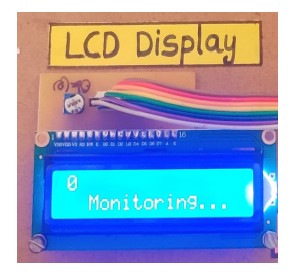
Figure 4. LCD Display
The LCD (Liquid Crystal Display) is a type of electronic display that uses the light-modulating properties of liquid crystals to display images or text (Ghosh et al., 2016). The LCD display is an essential component as it provides a visual feedback mechanism to users and enables them to check their access status to public areas quickly and easily.
4.2.4 LED Indicators
When an electric current flows through a Light Emitting Diode (LED), it creates light. Light is produced by the recombination of n-type semiconductor electrons with p-type semiconductor holes. The designed system utilizes red and green LED indicators to indicate whether the person is allowed or denied. Figure 5 shows the red and green LED indicators.
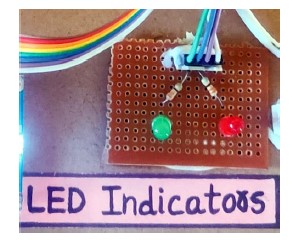
Figure 5. LCD Display
LED indicators are small electronic components used to indicate the status of a system. LED indicators are used to display the status of the system. A green LED indicate that a person is fully vaccinated and cleared to enter a public area, while a red LED indicate that a person is not vaccinated or not cleared to enter. The LED indicators in the system can be programmed to display different colors and blink patterns to provide additional information about the system's status. They are low-cost, easy-to-use, and provide visual cues that can help people quickly understand the status of the system.
4.2.5 Buzzer
A buzzer is a useful tool for incorporating sound characteristics into our system. It is a very compact and sturdy two-pin gadget, making it easy to use on a breadboard or PCB. As a result, this component is frequently employed in most applications. It gives beep sound when the vaccination is not done. Figure 6 shows the buzzer setup.
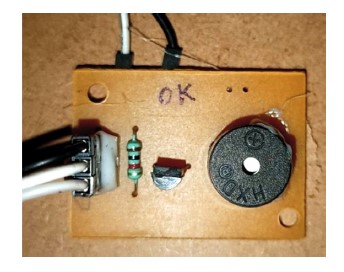
Figure 6. Buzzer
n this system, the buzzer is used to provide an audible alert to the user when their vaccination record is accessed and verified. It can also be used to indicate an error or warning message if there is a problem with the system or the user's vaccination record. The buzzer is connected and is controlled by the system software. It is an important component of the system's user interface and helps to ensure that users are notified of important information in a timely and efficient manner.
4.2.6 DC Servo Motor
A servo motor, or servo, is one type of electrical motor used to rotate machine parts with high precision. This motor includes a control circuit that provides feedback on the current location of the shaft of the motor, so this feedback simply allows these motors to revolve with high precision (Hubing et al., 1995). A servo motor is beneficial for rotating an object at some distance or angle. Figure 7 shows the DC servo motor.
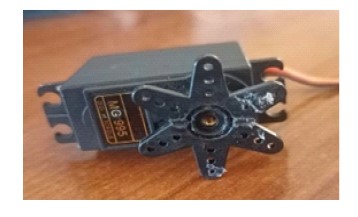
Figure 7. Buzzer
The DC servo motor is used to control the movement of the gate or door. It is connected to the Raspberry Pi Zero 2W through a motor driver, which receives instructions from the microprocessor to open or close the gate or door. The DC servo motor is a powerful and reliable motor that is ideal for precise control of movements in applications (Gambhir & Jha, 2013). It is an important component of the system that helps ensure accurate and efficient vaccine administration (Mahase, 2020).
4.2.7 PCB Converter
The LCD display output in this system is converted from 16 pins to 8 pins using a PCB converter. The complexity of the system is decreased because the 8 pins are connected to the Raspberry Pi 02W. A PCB converter is shown in Figure 8.
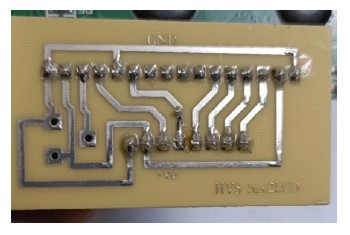
Figure 8. Buzzer
A PCB converter, also known as a voltage converter or voltage regulator, is a hardware component that converts one voltage level to another. The PCB converter is used to regulate the power supply for the various hardware components, including the Raspberry Pi Zero 2W, Pi Camera, LCD display, LED indicators, buzzer, and DC servo motor. The PCB converter ensures that each component receives the appropriate voltage to function optimally and prevents damage to the hardware due to voltage fluctuations. It is an essential component for the proper functioning of the system, providing stable power to all other components.
5. Circuit Diagram
The circuit diagram of the Vaccination Identification System consists of various components connected to the Raspberry Pi Zero 2W microprocessor. The system comprises a Pi camera, an LCD display, LED indicators, a buzzer, a DC servo motor, and a PCB converter. The Pi camera is connected to the Raspberry Pi Zero 2W, which captures images of the person seeking access to public areas. The images are then processed and compared with the person's vaccination records in the database. The LCD display is also connected to the Raspberry Pi Zero 2W, displaying the person's vaccination status and the result of the comparison process. The LED indicators provide visual feedback to the user and are connected to the microprocessor. A green LED indicates that the person is vaccinated, while a red LED indicates that the person is not vaccinated. Figure 9 illustrates the circuit of the designed system.
Figure 9. Circuit for the Designed System
The buzzer is used to provide audio feedback to the user. A beep sound is produced when a person is granted access, while a different beep sound is produced when a person is denied access. The DC servo motor is used to control the movement of the gate or door. It is connected to the Raspberry Pi Zero 2W through a motor driver, which receives instructions from the microprocessor to open or close the gate or door. The circuit diagram shows how the various components of the Vaccination Identification System are connected and work together to grant access to vaccinated individuals and deny access to those who are not vaccinated.
6. Software Requirement
Python is used for the development of the main program logic and user interface of the system. The system uses Python libraries such as Tkinter, NumPy, and Pandas to interface with the hardware and manipulate data.
Open CV, on the other hand, is an open-source computer vision and machine learning software library. It will be used to capture images and process them for facial recognition to verify the identity of the person being vaccinated. It provides functions for image and video capture, image processing, object detection and recognition, and machine learning.
The system runs on a Raspberry Pi Zero 2W board that will use a Linux-based operating system such as Raspbian or Ubuntu. The software requirements for the vaccination identification system include Python, Open CV, and a Linux operating system.
7. Working of the Project
The developed system will be fixed at the entrance of public locations like examination halls, shopping malls, and movie theatres, among others, so the first step is to verify the OTP. Figure 10 shows the OTP verification of the work.

Figure 10. OTP Verification
7.1 Case 1
In this case, the person completes all three doses of vaccination. A COVID vaccination certificate of all the doses completed by the person is shown in Figure 11.
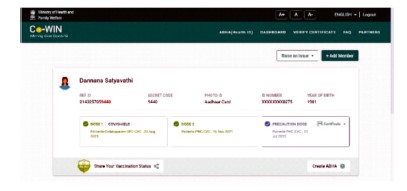
Figure 11. Covid Vaccination Certificate of All the Doses Completed Person
The Pi camera monitors the data and passes the signal to LED indicators and a DC servo motor to open the door. Figure 12 shows the green LED glowing and the door opening.
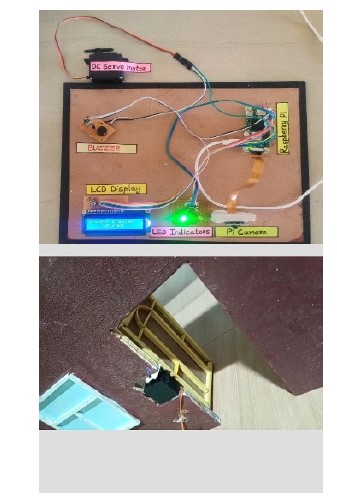
Figure 12. Green LED Glows and the Door Opens
According to Figure 12, if a person has finished all of the doses of COVID vaccination, the green LED will glow and the message "ACCESS GRANTED WELCOME" will be shown on the LCD. As a result, the servo motor gets activated, assisting in the opening of the door unit.
7.2 Case 2
In this case, the person does not complete all three doses of vaccination. A COVID vaccination certificate for a person with two doses completed is shown in Figure 13.
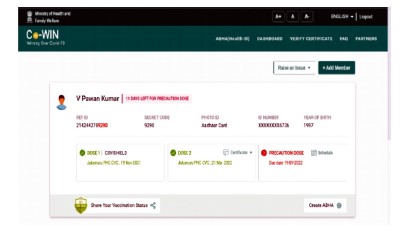
Figure 13. Covid Vaccination Certificate for Two Doses Completed Person
The Pi camera monitors the data and passes the signal to LED indicators and a DC servo motor. Figure 14 shows the red LED glowing, but the door does not open because of the conditions.
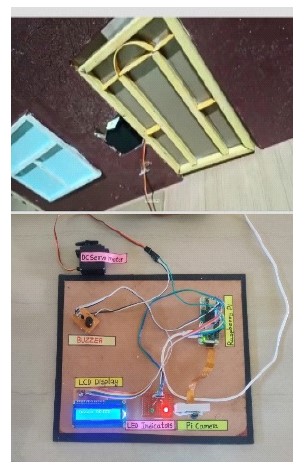
Figure 14. Red LED Glows and the Door Does Not Opens
According to Figure 14, above, if a person does not finish all of the doses of COVID vaccination, the red LED will glow and the message "ACCESS DENIED AND NOT GRANTED" will be shown on the LCD. As a result, the servo motor does not get activated, and the door unit remains closed
7.3 Advantages and Applications
The vaccination identification system has several advantages and applications. It utilizes the robust and efficient Raspberry Pi Zero 2W processor and the OpenCV image processing library to detect and monitor color text on the screen. The system provides audible alerts through the buzzer and visible alerts through the LCD display. It also features automatic door control using a DC servo motor based on the individual's vaccination doses. This system is highly beneficial in densely populated areas that require continuous monitoring and door access control.
It can be effectively utilized for monitoring and controlling entry into public places, ensuring that only vaccinated individuals are granted access. This is especially crucial during pandemics such as COVID-19. The system can also be used in workplaces and educational institutions to ensure the safety of students and employees. It is a cost effective and efficient solution to help prevent the spread of infectious diseases.
8. Results
The vaccination identification system project was developed to verify COVID-19 vaccination certifications using a Raspberry Pi and image processing on a door access system. The system can only grant access if the Pi camera recognizes the persons who are vaccinated and gets a green signal which signals the Raspberry Pi to unlock the door and allow the person to enter.
This research provided us with a better understanding of our local communities, the COVID-19 pandemic situation, and the various tools used for verification. It also highlights the importance of planning and teamwork to achieve success. Such initiatives could be effective in compiling, examining, and visualizing COVID-19 cases and their impact on different aspects of the community. This analysis made us feel more connected to our community. During the research period, the CoWIN app did not load the specific person's vaccination details.
Conclusion
The vaccination identification system has several features that integrate all of the hardware components used. The presence of each module has been carefully thought out and arranged to contribute to the unit's optimal performance. Second, the System consists of various components connected to the Raspberry Pi Zero 2W microprocessor and grants access to vaccinated individuals but denies access to those who are not vaccinated. The main goal of this research is to achieve 100% vaccination to prevent the spread of dangerous diseases. Thus, the system has successfully helped avoid the spread of COVID-19.
